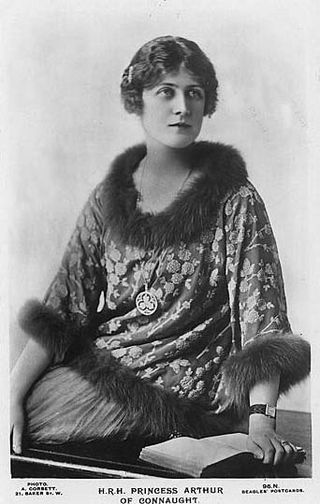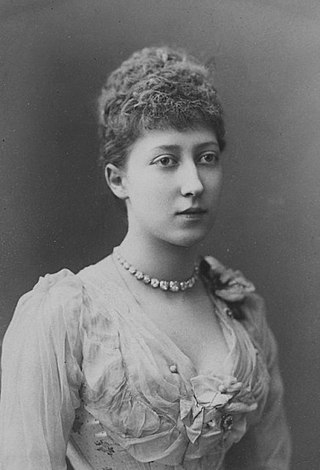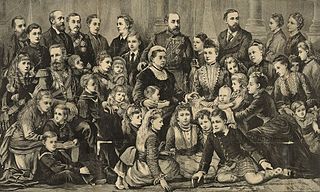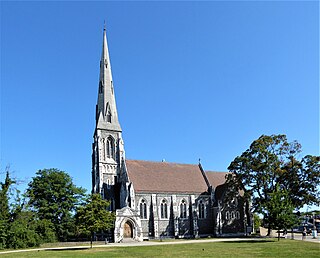Related Research Articles

Alfred was sovereign Duke of Saxe-Coburg and Gotha from 1893 to 1900. He was the second son and fourth child of Queen Victoria and Prince Albert. He was known as the Duke of Edinburgh from 1866 until he succeeded his paternal uncle Ernest II as the reigning Duke of Saxe-Coburg and Gotha in the German Empire.

Princess Alice, Countess of Athlone was a member of the British royal family. She was the last surviving grandchild of Queen Victoria. Princess Alice was the chatelaine of Rideau Hall in Ottawa from 1940 until 1946, while her husband Alexander Cambridge, 1st Earl of Athlone, served as Governor General of Canada.

Francis, Duke of Teck,, known as Count Francis von Hohenstein until 1863, was an Austrian-born nobleman who married into the British royal family. His wife, Princess Mary Adelaide of Cambridge, was a first cousin of Queen Victoria. He was the father of Queen Mary, the consort of King George V. Francis held the Austrian title of Count of Hohenstein, and the German titles of Prince (Fürst) and later Duke of Teck, and was given the style of Serene Highness in 1863. He was granted the British style of Highness in 1887.

Prince Leopold, Duke of Albany, was the eighth child and youngest son of Queen Victoria and Prince Albert. Leopold was later created Duke of Albany, Earl of Clarence, and Baron Arklow. He had haemophilia, which contributed to his death following a fall at the age of 30.

Princess Helen of Waldeck and Pyrmont VA, CI, RRC, GCStJ was a member of the British royal family by marriage. She was the fifth daughter and child of George Victor, Prince of Waldeck and Pyrmont, and his first wife, Princess Helena of Nassau.

Princess Alexandra, 2nd Duchess of Fife,, born Lady Alexandra Duff and known as Princess Arthur of Connaught after her marriage, was the eldest surviving grandchild of King Edward VII and also the first cousin of George VI. Alexandra and her younger sister, Maud, had the distinction of being the only female-line descendants of a British sovereign officially granted both the title of Princess and the style of Highness.

Louise, Princess Royal and Duchess of Fife was the third child and eldest daughter of King Edward VII and Queen Alexandra of the United Kingdom; she was a younger sister of King George V. Louise was given the title of Princess Royal in 1905. Known for her shy and quiet personality, Louise remained a low-key member of the royal family throughout her life.

Lady May Helen Emma Abel Smith was a relative of the British royal family. She was a great-granddaughter of Queen Victoria and a niece of Queen Mary. She led a private life in Britain. From 1958 until 1966, she lived in Brisbane, while her husband, Sir Henry Abel Smith, served as the governor of Queensland.

Sir Arthur William Blomfield was an English architect. He became president of the Architectural Association in 1861; a Fellow of the Royal Institute of British Architects in 1867 and vice-president of the RIBA in 1886. He was educated at Trinity College, Cambridge, where he studied Architecture.

Sir Reginald Theodore Blomfield was a prolific British architect, garden designer and author of the Victorian and Edwardian period.


Queen Victoria, the British monarch from 1837 to 1901, and Prince Albert had 9 children, 42 grandchildren, and 87 great-grandchildren.

Honouring individuals buried in Westminster Abbey has a long tradition.

St George's Chapel at Windsor Castle in England is a castle chapel built in the late-medieval Perpendicular Gothic style. It is a Royal Peculiar, and the Chapel of the Order of the Garter. St George's Chapel was founded in the 14th century by King Edward III and extensively enlarged in the late 15th century. It is located in the Lower Ward of the castle.

St. Alban's Church, locally often referred to simply as the English Church, is an Anglican church in Copenhagen, Denmark. It was built from 1885 to 1887 for the benefit of the growing English congregation in the city. Designed by Arthur Blomfield as a traditional English parish church in the Gothic Revival style, it is in a peaceful park setting at the end of Amaliegade in the northern part of the city centre, next to the citadel Kastellet and the Gefion Fountain and Langelinie.

St Mary's Church is a Church of England church in Plaistow in the (East-) London Borough of Newham. With the three churches of St Matthias’, St Martin's, and St Philip and St James’, it now forms part of the Parish of the Divine Compassion. Its Victorian building, designed by Sir Arthur William Blomfield in 1890-1894, was demolished in 1976. They now worship in a smaller church built in 1981.
Charles Edgar Buckeridge was an English church decorative artist and the son of Charles Buckeridge, a Gothic Revival architect.

The wedding of Prince Henry, Duke of Gloucester, and Lady Alice Montagu Douglas Scott took place on Wednesday, 6 November 1935, in the private chapel at Buckingham Palace. A larger public ceremony had been planned for Westminster Abbey, but plans were scaled back after the bride's father, the 7th Duke of Buccleuch, died of cancer on 19 October.

Christ Church, Marylebone, also called Christ Church, Lisson Grove, and Christ Church, Cosway Street, is a Grade II* listed former Church of England church, built in the 1820s in Marylebone in the City of Westminster to designs by Thomas and Philip Hardwick.
References
- ↑ "Memorial Chapel To The Duke Of Albany". Times [London, England]. 26 February 1885 – via The Times Digital Archive.
- ↑ "THE ALBANY MEMORIAL AT CANNES". Waikato Times. Vol. XXVIII, no. 2303. 14 April 1887.
- ↑ "The Albany Memorial at Cannes". London Standard Newspaper. 14 February 1887. p. 8.
- ↑ "The Confirmation of Princess Alice of Albany at St George's Church, Cannes". Illustrated London News. 16 April 1898. pp. 5, 6.
- ↑ "EGLISE SAINT-GEORGES". LA PAROISSE CATHOLIQUE SAINT NICOLAS.
- ↑ "Art Notes". Pall Mall Gazette. 12 October 1892. p. 1.